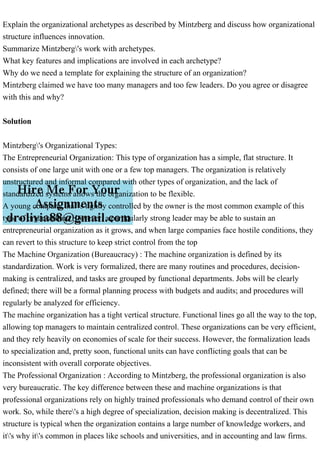
Explain the organizational archetypes as described by Mintzberg and .pdf
- 1. Explain the organizational archetypes as described by Mintzberg and discuss how organizational structure influences innovation. Summarize Mintzberg's work with archetypes. What key features and implications are involved in each archetype? Why do we need a template for explaining the structure of an organization? Mintzberg claimed we have too many managers and too few leaders. Do you agree or disagree with this and why? Solution Mintzberg's Organizational Types: The Entrepreneurial Organization: This type of organization has a simple, flat structure. It consists of one large unit with one or a few top managers. The organization is relatively unstructured and informal compared with other types of organization, and the lack of standardized systems allows the organization to be flexible. A young company that's tightly controlled by the owner is the most common example of this type of organization. However, a particularly strong leader may be able to sustain an entrepreneurial organization as it grows, and when large companies face hostile conditions, they can revert to this structure to keep strict control from the top The Machine Organization (Bureaucracy) : The machine organization is defined by its standardization. Work is very formalized, there are many routines and procedures, decision- making is centralized, and tasks are grouped by functional departments. Jobs will be clearly defined; there will be a formal planning process with budgets and audits; and procedures will regularly be analyzed for efficiency. The machine organization has a tight vertical structure. Functional lines go all the way to the top, allowing top managers to maintain centralized control. These organizations can be very efficient, and they rely heavily on economies of scale for their success. However, the formalization leads to specialization and, pretty soon, functional units can have conflicting goals that can be inconsistent with overall corporate objectives. The Professional Organization : According to Mintzberg, the professional organization is also very bureaucratic. The key difference between these and machine organizations is that professional organizations rely on highly trained professionals who demand control of their own work. So, while there's a high degree of specialization, decision making is decentralized. This structure is typical when the organization contains a large number of knowledge workers, and it's why it's common in places like schools and universities, and in accounting and law firms.
- 2. The Divisional (Diversified) Organization : If an organization has many different product lines and business units, you'll typically see a divisional structure in place. A central headquarters supports a number of autonomous divisions that make their own decisions, and have their own unique structures. You'll often find this type of structure in large and mature organizations that have a variety of brands, produce a wide range of products, or operate in different geographical regions. Any of these can form the basis for an autonomous division. The Innovative Organization ("Adhocracy") : The structures discussed so far are best suited to traditional organizations. In new industries, companies need to innovate and function on an "ad hoc" basis to survive. With these organizations, bureaucracy, complexity, and centralization are far too limiting. Organizational theories have long considered the ways in which organizations evolve and adapt to their environments, including the influence of technological change on the evolution of organizations (see, Tushman and Nelson 1990). A core debate concerns whether organizations can change and adapt to major discontinuous technological change and environmental shifts, or whether radical change in organizational forms occurs principally at the population level through the process of selection (Lewin and Volberda 1999). This literature includes at least three broad views on the nature of organizational adaptation and change. Organizational ecology and institutional theories, as well as evolutionary theories of the firm, emphasise the powerful forces of organizational inertia and argue that organizations respond only slowly and incrementally to environmental changes. This strand of work focuses on the way environments select organizations, and how this selection process creates change in organizational forms. A second view, the punctuated equilibrium model, proposes that oganizations evolve through long periods of incremental and evolutionary change punctuated by discontinuous or revolutionary change. It sees organizational evolution as closely linked to the cyclical pattern of technological change. The punctuated model regards organizational transformation as a discontinuous event occurring over a short period of time. The third perspective, which might be described as strategic adaptation, argues that organizations are not always passive recipients of environmental forces but also have the power to influence and shape the environment. The strategic adaptation perspective stresses the role of managerial action and organizational learning, and the importance of continuous change and adaptation in coping with environmental turbulence and uncertainty. Yes, i agree because all the managers are not managers this is because only few of the managers are expert in solving managerial problems and are expert in their field of work. Like wise all the leaders are not true leaders a leader is one who can change the whole gamut by his leadership and only few leaders posses this quality.